Archive for ‘General’ Category
Cyberspace-Age Cinema Pummels Paper Piles…or Does It?
In the olden days (that is, when Paper Doll was still young enough to think the olden days involved the kind of wardrobe you see on AMC’s Mad Men), going to the movies was an activity low on the paper clutter scale. If went to a play, a musical, a concert or even the circus, you were likely to get a program, a brochure, or some sort of sizable paper memorabilia.
But the movies? Even if you were the sort of person who became so sentimentally attached to the experience (first date? baby’s first Disney film?) and felt compelled to save the ticket stub, the tickets were relatively tiny.

 You could save many years’ worth of movie-going stubs in an envelope until your spouse “accidentally” tossed it out, or you could lovingly paste the stubs into scrapbooks. But even if you went to the movies every single week, movie-watching just didn’t produce clutter.
You could save many years’ worth of movie-going stubs in an envelope until your spouse “accidentally” tossed it out, or you could lovingly paste the stubs into scrapbooks. But even if you went to the movies every single week, movie-watching just didn’t produce clutter.
And then came online DVD rental. By now, most people have experienced Netflix (or the similar Blockbuster Online) and the nifty little snip-slide-view-slide-rip-fold-seal-mail ritual of the specialized envelopes. The idea is brilliant: rent movies and return them with minimal effort and no charge for postage. It was especially intriguing for people who used to rent videos but forgot to return them, racking up huge late fees, as well as for those who made lists of the movies they wanted to see and then forgot to take the lists to the store.
This modern era of movie watching has eliminated late fees and lost movie lists. Once you set up an account, you create a queue, your laundry list of movie (and TV series) titles you want to rent. You can easily add, remove or change the order of the items in your queue. The top movie on your list is sent automatically, and once you return a DVD, the next title is sent. No late fees or fines for pokey viewers or forgetful consumers. But the new solution, as we’ll soon see, has created some new problems.
REMEMBERING TO RETURN
Forgetting to return a DVD doesn’t cost money in terms of fines, but that doesn’t mean you’ll get your money’s worth. Are you an Absent-Minded Professor? If your problem is remembering to return DVDs, so you’ve not only got paper clutter but unreturned DVD clutter, cyberspace-age help is available.
FeedFlix.com is your own personal Jeeves (DVD-reminder service)–plus, it’s free! Sure, we’ve talked about cool online reminder services before, but this one works along with your Netflix account with minimal initial effort on your part. You probably didn’t even know your Netflix queue had an RSS feed (yes! just like a blog), but it does, and that’s the key to making sure you get the biggest bang for your movie buck:
- Visit http://www.netflix.com/rss to identify your personal queue’s RSS feed code. (Don’t worry if you don’t know HTML from AARP–you’ll merely have to cut and paste.)
- Enter it in the box that looks like this:

- Verify your login name and password.
Within minutes, FeedFlix is busy calculating all sorts of interesting info about your Netflix account. For example, given your monthly plan and your speed (or lack thereof) in returning movies), it will identify your relative rental cost per movie. For a sample:
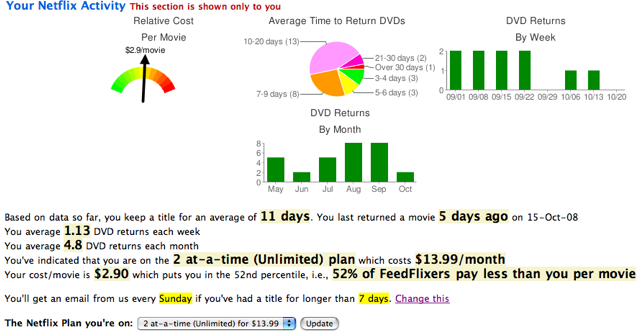
So, if FeedFlix finds that you’re like Uncle Joe (he’s movin’ kinda slow), it’s a cue to either watch and return your movies more quickly or change your rental plan to fewer movies per month. Why spend to three movies at a time (the standard) if it takes you two weeks to watch and return a DVD?
Even better, FeedFlix has account alerts, which you can set for the day of the week you prefer, to tell you if you’ve kept a movie too long to make it worth your monthly cost. (You can pick 3, 5, 7, 10 or 15 days.) So, Netflix (for which you pay) can be monitored by FeedFlix (which is free) to make sure you get your money’s worth…and eliminate paper and DVD clutter from around your home. It also helps save those little green pieces of paper we all love.
By the way, if you’re one of those developer/programmer types who lives to make apps (applications, for the rest of us Luddites) for Facebook and the iPhone, Netflix has made it possible for you to create your own Netflix-based funky-cool applications, just like FeedFlix. Just don’t expect Paper Doll to understand any of them.
NOW WHAT WAS THE NAME OF THAT MOVIE?
So, let’s backtrack. Modern movie watching helps us save money and reduce clutter when it comes to getting movies returned. But what about paper clutter created when we try to find movies?
Have you ever tried on a heavy winter coat for the first time all season, only to put your hand in your pocket and pull out a crinkled ATM receipt or sticky note bearing the scribbled title of the movie you wanted to see all last summer?
As long as you can remember the title (or the stars or the genre or any other searchable attribute) long enough to get to your your computer or mobile device and the movie to your queue, you’re all set. No more wandering video store aisles in search of a match for a vaguely recalled movie promo. No more messy lists or forgotten titles. The 21st century rocks!
For reference, Paper Doll is not assessing the relative merits of Netflix vs. Blockbuster Online. I admit that I’m a Netflix customer; however, I do see the advantage of Blockbuster Online’s Total Access, which allows you to return movies rented online at actual stores (assuming you still have a brick and mortar video store in your area) and get a new DVD. For those who have a burning need to see a particular flick right this minute, that’s an advantage.
Enjoyed it while it lasts. We loved Polaroid pictures, but they’re a technology of days gone by. Now, Netflix and Blockbuster Online allow on-demand viewing, bypassing the U.S. Postal Service and the need for return envelopes in the first place. (Yet another chance to reduce paper clutter!) The services have been offering PC users the option for a while, and now Mac users will be able to have Netflix magically beam movies into their homes, too. But until that’s widespread, let’s talk about that pesky paper clutter.
THE DVD/PAPER CLUTTER PROBLEM
OK, so you’ve got an online DVD account. You create your list or queue of the movies you want to see, and then prioritize them in some order that make sense to you. And then the movies start showing up in your mailbox:
- The envelope arrives.
- You break the seal made by the the little white dot.
- You slide the DVD sleeve out of the envelope.
- You slide the DVD out of the sleeve.
- You watch the DVD…or don’t.
- Lather, rinse, repeat.
- Eventually, you decide to return the DVD and put the DVD in the sleeve and the sleeve in the envelope. Here’s where trouble arises.
- You tear the extra (flappy) advertising page off at the perforation and you remove the plasticized paper strip covering the adhesive.
- You fold over the edge to seal the package, and give the Netflix envelope to your friendly, neighborhood postman,
 Mr. McFeely, for speedy delivery.
Mr. McFeely, for speedy delivery.
So what’s the problem? You still have the flappy advertising page and the plasticized paper strip. You know you should pick them up, walk them to the recycling or trash bin and get them out of you living room. You know that. But instead, you keep them. You let them pile up around your kitchen and TV room and front hall.
You know you don’t need to file the flappy page. You don’t need to shred it, either. Yes, your name and address are on the reverse side, but these are a matter of public record. So, unless you joined Witness Protection but had your old Netflix account forwarded to your new address–in which case, paper clutter probably isn’t your most serious problem–there’s no need to shred the flappy advertising page.
I wish I could tell you there’s an official professional organizer secret to throwing out these scraps, but the truth is, this one depends on self-discipline. You have to actually make the decision to get the piles of paper clutter, the flappy pages and skinny strips, to the bin. No secrets. The best I can offer are some tips:
- Open your DVD rentals when and where you open the rest of your mail.
If you’re following our game plan, as soon as the mail comes in, you’re taking the time to open each piece of mail, tossing the external envelopes, the shiny advertising copy and the unnecessary inserts.
If you’re doing this daily, tossing out flappy advertising pages easily becomes part of your ritual. Then, bills get carried to the household billpaying center, DVDs get carried to the logical home (coffee table? remote control stand? counter above the DVD player?), and so on with the rest of your mail. (This solves the flappy advertising page clutter. However, since you can’t pull the strip off the adhesive until you’re ready to mail your DVD back, the strips may still create clutter.)
- Create a ritual and schedule your activities.
To get yourself to return the DVD in the first place, you need to encourage yourself to pack up your shipment. If paper clutter is generally an issue anyway, set an alarm on your cell phone or computer for the same time every day, and make a quick sweep around the family room to pick up paper clutter, toss it and then package up your DVDs.
- Put a trash can or recycling bin in the TV viewing area.
The more convenient an item’s home is, the more quickly and easily it’s put away. If the flappy advertising page and the plasticized paper strip have a home in the trash, keep the trash can close at hand.
- Give up on organizing and trade order for art.
I know, it’s almost sacrilegious for Paper Doll to turn people away from organizing, but there are just such adorable alternatives. So, at least for today, reflect on occasionally skipping the step of tossing or recycling the flappy advertising pages. Make the world a goofier, more beautiful place by following the step-by-step guidance of NetflixOrigami.com.


- And finally, be glad Netflix has evolved, and take a gander at this slide show of how Netflix’s DVD packaging has changed since 1999. Without this evolution, your home would be more cluttered and our environment would be less green.
It’s a beautiful day. Go watch a movie!
Groucho Told Me “Say the Secret Word” To Win Access To My Sites (Password Talk)
 On the old television show, You Bet Your Life, Groucho Marx would encourage contestants to “say the secret word” and the audience would watch with baited breath to see if the prize-winning word would be uttered. If so, the prize duck, complete with Groucho-glasses and mustache
On the old television show, You Bet Your Life, Groucho Marx would encourage contestants to “say the secret word” and the audience would watch with baited breath to see if the prize-winning word would be uttered. If so, the prize duck, complete with Groucho-glasses and mustache  would drop from the ceiling and HURRAY, the contestant would win the prize. No magic word? No prize.
would drop from the ceiling and HURRAY, the contestant would win the prize. No magic word? No prize.
Do you ever feel like trying to remember the correct internet password is like being a contestant on a game show? If you win, you can transfer money from one account to another or post an update on your blog. If you lose, you may struggle for hours to gain access to your accounts or files. Sometimes, frustrated, the best you can hope for is to go home with a parting gift of Rice-A-Roni (the San Francisco treat).
Previously, we’ve discussed why it’s dangerous to leave your passwords on your desk and monitor. Who wanders by your office computer? Customers, vendors, consultants? Friends and family of other employees? Maintenance staff and colleagues? Who else? Can you be certain that you’re safe from corporate espionage and identity theft?
Even in a home office, where only the UPS guy and babysitter see your desk, it’s crucial to protect sensitive data from disclosure—whether that’s your own Social Security number and bank data or your clients’ proprietary information. The more clutter in your desktop environment, the harder it is to know when something is missing or if prying eyes have settled on them.
The same is true if you’ve got a mini Post-It taped to your laptop. Turn away from your screen for a moment to get a napkin to wipe up the coffee this random guy at Starbucks just spilled and…YIKES! Random Guy’s partner-in-crime just made off with your laptop, passwords, identity and financial future!
If you’re a long-time Paper Doll reader, you know how I bemoan floozies. Well, having your login name and password on an accessible, visible (albeit tiny) piece of paper is a disaster waiting to happen. In a future post, we’ll review the advantages and disadvantages of various paper and digital alternatives to floozies and undependable memories, but today, I have something special to share.
Back when we were talking about identity theft, I said:
Well, the folks at Innovention Lab have done my cheat sheet one better with the Internet Password Organizer™. Now, you don’t need to encode your passwords (though you still could do so) because your passwords, though accessible, are no longer visible to every Groucho, Harpo and Zeppo.
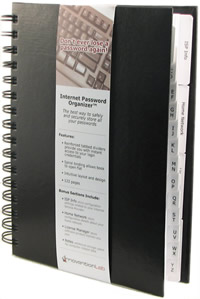
The Internet Password Organizer™, upon cursory examination, looks like any ordinary address book. The 5.5″ x 8″ covers are made of marbled, black paperboard, firm to the touch and likely to survive multiple drops and dings. The binding is double-loop or Wire-O rather than the more common but less hardy comb or coil-style binding, so you don’t have to worry about the binding unraveling. The binding makes it easy to open the book and lay it flat to add new entries.
From most angles, it could easily pass for a personal journal or diary. So, unless a thief wants to know about your latest crush, the Internet Password Organizer™ is unlikely to inspire any curiosity, whether you keep it on your reference bookshelf, on your desk or locked in a drawer. (Note: The narrow label wrapper you see above simply slides off, leaving no indication of the contents.)
There are 13 tabbed dividers with the alphabet pairings (AB, CD, EF, etc.) on both sides, a boon to lefties (or anyone writing in Hebrew)! Each individual page provides the opportunity to list the login information (web page name, username, password and ample room for comments/notes) for five sites.
The Internet Password Organizer™ is sold online its own website, at OnlineOrganizing.com, Amazon.com and other retailers for $19.99.
The Extras
Innovention Lab would have a fine product with just the basics, but the Bonus Sections give the Organizer a chance to shine because they remembered what we always forget. Click the links to see the page layouts:
- ISP (Internet Service Provider) Info–Be honest, in an emergency, what’s the chance that you could find the notes from when you first switched ISPs? The Organizer provides a gentle nudge to collect and record info about your network settings, server information and technical support contacts, with prompts for all the details you just know you’d otherwise have missed.
- Home Network Configuraton Info–I won’t steal Innovention Lab’s thunder. Suffice it to say they remembered all the things you need to know to configure your home network and keep your modem, router, networks and wireless settings from going kafflouie, or to reconfigure after you’ve become a kafflouie victim.
- License Manager–You know how impossible it is to get technical support for software issues if you can’t prove you are the lawful license-holder. Again, the Organizer rocks with ample space for logging all the software data that keeps you sane, safe and happy.
- Notes–They even added a notes section, because there are always procedures and protocols for fixing problems that pop up just infrequently enough that you forget what to do. The Internet Password Organizer™ saves you from wasting valuable timing calling tech support (or bruising your ego, calling a tech-savvy ex).
What Paper Doll liked:
- The simplicity of the design. Discretion may be the better part of value, but it’s the be-all and end-all of internet security. Nothing about the design calls attention to it as a technical security tool. It’s a blunt-cut bob. A beige four-door sedan. An American cheese sandwich. The design lets the Internet Password Organizer™ hide in plain sight.
- The ease of use. The promotional material notes the “intuitive layout and design”, and one cannot argue. A seven year-old could understand how and where to record essential data.
What Paper Doll loved:
- It’s low-tech–there’s no learning curve whatsoever. You, your kids and Great-Grandma Gert can all start using the Internet Password Organizer™ without having to read a manual, download any software or firmware, or create a password for your passwords!
- The bonus features. Any Hello Kitty address book could be reconfigured for recording URLs and passwords, but the bonus section serves in lieu of your own professional organizer for reminding you which technical information you need to gather and preserve. A+ to Innovention Lab for doing the thinking for us, especially for those of us who don’t know a WAN from a LAN from a sodapop can, or a subnet mask from a Halloween mask.
A few (minor) drawbacks:
You can’t really travel with your Internet Password Organizer™, or you’ll dramatically increase your risk of loss . After all, keeping both your laptop and secret passwords in the one bag carry-on bag means that if a thief gets one, he gets everything. However, this would be a problem with any non-technical security protocol. In future posts, we’ll talk about high tech gizmos that protect access with thumb prints or generate new umbrella password keys every few minutes. However, with added technology comes added costs, while the Internet Password Organizer™ is priced conservatively.
It’s not expandable. You get 5 web sites per page, with room for entries on the front and back of every page. Each divider tab represents 2 letters of the alphabet, so behind each tab, you have room for 40 passwords. For the typical user, this should be more than adequate, but power users might welcome an upgrade. Perhaps someday an Internet Password Organizer™ version 2.0 could include double the number of pages, or small binder rings instead of spiral binding to allow for pages to be added.
Two suggestions for improvement:
- The first page bears the name Internet Password Organizer™, and the reverse side of that page says the same, along with providing a place to provide your name, phone number and email address if the book is found.
On the one hand, I applaud Innovention Lab for putting this data on the reverse of the front page so that someone who opens the book and is inclined to use it will not immediately notice he/she has access to even more personal information. On the other hand, I’d love to see a false front page added without the product’s name. (Perhaps it could just say Innovention Lab?) Then again, perhaps reviewing this product has made me a little too much of a paranoid Agent 005 (License to File).
- A special section for web site owners would be great, or perhaps this could be a new line extension for Innovention Lab altogether.
As more and more of us have our own web sites and blogs, we’re acquiring even more passwords for managing our sites’ control panels and maintaining our IP addresses and domain registrations. There’s no reason the existing sections of the Organizer can’t suffice, but a whole new section (perhaps as part of a deluxe version) would probably sell like hotcakes to all of us who are slowly growing our online empires.
The Bottom Line:
The product promises it’s “the best way to safely and securely store all your passwords”. With a deceptively simple design and no fanfare, it helps you protect your online privacy and manage your computer discretely, cost-effectively and simply. If only our computers behaved so well!
At the risk of sounding like a politician, Paper Doll approves of Innovention Lab’s Internet Password Organizer™. (And that’s the secret word!)
Whistler’s Mommy Invites Grandchild Moses and Raggedy Andy Warhol For A Playdate
Do you sometimes feel like you’re the curator of the MMOTA (Modern Museum of Toddler Art) or the AMOKAC (American Museum of Kindergarten Arts and Crafts)?
Do you feel obligated to believe a picture is worth a thousand words because you can’t understand half of what your toddler says?
 Have you forgotten what color your refrigerator is because the doors, like museum walls, are covered with all of the major artistic methods–watercolor, oil(y Play-doh), and mixed media (painted, sparkly macaroni)?
Have you forgotten what color your refrigerator is because the doors, like museum walls, are covered with all of the major artistic methods–watercolor, oil(y Play-doh), and mixed media (painted, sparkly macaroni)?
Today, we start the second year of the Paper Doll blog, so it seems appropriate, given this auspicious time, to talk about children’s art as our own little cooperative masterpiece of a blog enters its toddler years.
When children are very young, every artistic endeavor may seem like a masterpiece, but soon enough, parents can become overwhelmed by the embarrassment of finger-painted riches. At some point, you realize you’re either going to have to start buying Frigidaires in bulk, or you’re going to run out of display space in this kiddie art gallery you used to call your home.
Unlike the other categories of paper we’ve discussed in the past: bills, to-do lists, references papers, Social Security cards…there’s no agreed-upon records retention schedule available for determining how long one should keep art created by tiny hands. So, today, we’re going to explore some ways of looking at two aspects of handling children’s art: displaying the work and winnowing the collections.
First, before you run to Fridges-Are-Us for your next art wall, recognize that there are alternatives to hanging art where your lunch lives.
THE CLASSICS
Hang a clothesline a few inches below ceiling height (too high for children to climb to reach) and hang paper artwork, attaching it with clothespins. This can be a fun way to decorate your child’s room as well as any other bare but casual area, like a guest room, mud/utility room, playroom or basement. You can make it a permanent display gallery with rotating collections, or you can put on an ad hoc art show.
Invest in a large cork board and affix it to a bare wall. You can display the art as-is, right on the cork, or cover the entire board with dollar-store wrapping paper or white or brown kraft paper. In the latter case, your kids can draw on or decorate the kraft paper (also called butcher paper), first, creating a meta-message of art-on-art.
Wallpaper an unfinished basement. The walls of a basement laundry room are likely to be gunmetal grey and depressing. Charming and colorful children’s art can brighten the area (and the mood of laundry day) immensely. The works can be easily and safely attached to walls with removable Command Picture Hanging Strips.
Frame it or Contain it. Whether you’re a do-it-your-self framer, prefer a fun kid-themed frame or desire opportunities for frequent changes of display as afforded by this 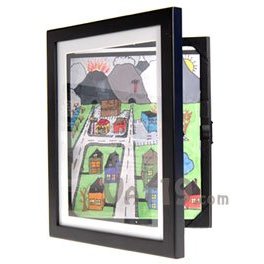 L’il Davinci art cabinet, no rogue art or craft will ever complain that it was framed.
L’il Davinci art cabinet, no rogue art or craft will ever complain that it was framed.
Embroider it! This may not be a classical type of display, but this FeelingStitchy blogger’s crafty talents are put to excellent use in framing and displaying her grandchildren’s art.
MODERN ART
“Take a picture; it’ll last longer.” OK, that saying still sounds a little snarky, but it’s a perfect option for preserving mixed-media and other three-dimensional works of art. Better yet, take a snapshot of your child  holding the masterpiece to keep a historical record your little star during his or her Blue Period.
holding the masterpiece to keep a historical record your little star during his or her Blue Period.
Scan the artwork using standard scanning software; for larger pieces, you will have more luck with a full-sized scanner than the popular handhelds. Suppress acting on your temptation to color-correct green hair or fix the spelling mistakes that actually make children’s art delightful.
Create greeting cards and calendars  you can share with family and friends. You can make the calendars yourself by laminating pages and having them spiral-bound at Kinko’s or your local printing shop; they can print your cards, too. Or, you can have your favorite online or offline photo developing company mass-produce calendars or cards in bulk.
you can share with family and friends. You can make the calendars yourself by laminating pages and having them spiral-bound at Kinko’s or your local printing shop; they can print your cards, too. Or, you can have your favorite online or offline photo developing company mass-produce calendars or cards in bulk.
Upload the scanned art to flickr or other photo-sharing social networking web sites.
Create a web site using a free blog template and upload the art for all the world to see. Send the link to grandparents, family, friends and chat about it on Facebook or Twitter. Let your little Michelangelo or Georgia O’Keeffe develop a world-wide following. (Of course, make sure to use safety protocols and don’t identify your child’s name or location on public sites.)
Use Digital Picture Frames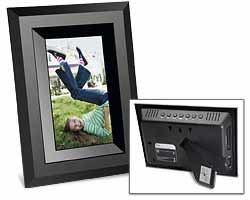 If grandparents or great-grandparents haven’t quite joined the digital age and don’t use computers, it’s OK. You can load a series of photos of the art (as well as snapshots of the whole family) onto a memory card and plug it into a digital picture frame for them. Of course, it can’t hurt to send along an occasional piece of paper artwork along with a letter that says “Dear Grandma and Grandpa” or “Dear Bubbe and Zayde”, or “Dear Baba and Gigi”, or “Dear Abuela and Abuelo”…
If grandparents or great-grandparents haven’t quite joined the digital age and don’t use computers, it’s OK. You can load a series of photos of the art (as well as snapshots of the whole family) onto a memory card and plug it into a digital picture frame for them. Of course, it can’t hurt to send along an occasional piece of paper artwork along with a letter that says “Dear Grandma and Grandpa” or “Dear Bubbe and Zayde”, or “Dear Baba and Gigi”, or “Dear Abuela and Abuelo”…
AVANT GARDE
Every parent believes his or her child’s art is a tour de force. The parents of these little girls took it the next step, and put their daughters’ art on display at the Peez Leweez coffee house  in Livingston Manor, NY (about halfway between Binghamton and New York City) along with the creations of other local artists. Sales of the works brought in legal tender (which was donated to charity). If you or someone you know owns a bookshop, coffee house or other venue with walls suitable for gallery displays, this could be the bees knees for entrepreneurial types and parents of prolific artistes.
in Livingston Manor, NY (about halfway between Binghamton and New York City) along with the creations of other local artists. Sales of the works brought in legal tender (which was donated to charity). If you or someone you know owns a bookshop, coffee house or other venue with walls suitable for gallery displays, this could be the bees knees for entrepreneurial types and parents of prolific artistes.
CURATING YOUR COLLECTIONS
Eventually, the issue of art displays will become secondary to the need to conquer piles of paper art. It can become overwhelming, especially in small houses or large families. It’s necessary to pare down your artistic collections. Here’s one process that might work for your family:
Whatever gets created that week is put on display…no exceptions. It doesn’t have to be pretty: Beauty is in the eye of the beholder, and if your second-grader beholds you as a 300 pound giant with three arms all on one side of your body, whose to say she’s not the next Picasso? It’s the Exhibit of the Week!
At the end of the week, take everything down to make room for next week’s work. Ask your child if he or she would like to find one piece to mail to loved ones in paper form. Do not, however, send everything to the grandparents or they’ll end up with clutter!
Next, weed out any the pre-drawn, pre-cut designs from coloring books. Let go of the art that doesn’t really represent your kids’ true abilities–I’m sure the mommy of guy who draws Pilgrims for holiday-themed coloring books is already proud of him, so you don’t have to honor his work. This like an art appraiser, and concentrate on your artist’s originals and not the mass reproduced knock-offs.
Collect what’s left in a flat, clean box. You can buy art storage boxes at The Container Store, but it might be easier to ask your local pizzeria to throw in an extra (unused) large pizza box or two the next time you have a big pizza party. Then, set the art aside to “marinate” (as my colleague Allison Carter says) for a month or more. Once the contents of the box has been out of sight for a while, your kids‘ attachment to the art as well as yours will have diminished, and you’ll be able to select no more than a half dozen to a dozen pieces representative any year of artistic expression.
With this winnowed but elite collection, you can preserve art in paper form in the pizza boxes, or in more formal scrapbooks or albums. Or, you can use long, cylindrical cardboard tubes (e.g., wrapping-paper tubes, mailing canisters or architect’s design tubes). Obviously, however, you may afford to be much less parsimonious with your gallery’s collections if you plan to transfer the art to digital form. Just remember to group the preserved paper collections with other memorabilia and away from the cold and damp prevalent in basements, or the excessive heat or humidity of attics, garages or crawlspaces.
Parents, enjoy your children’s art, and enjoy their creative processes, without living amid layers of flaking paint and piles of crumbling construction paper. Revel in your role as Curator of the Museum of Little Folks’ Art.
First Anniversary Gift for Paper Doll Readers
Happy New Year, Paper Doll readers!
A few of you, reading this upon awakening, are blinking confusedly (like an old VCR perpetually stuck at 12:00) and wondering what I’m talking about. No, you didn’t Rip Van Winkle your way through Election Day and the winter holiday hubbub.
Others are assuming I’m wishing them a L’Shanah Tovah, or Happy Rosh Hashanah (the Jewish New Year), and might be expecting me to metaphor my way into getting prepared to buy calendars (as 2009 is only 92 days away!) or even regale you with esoteric tales of all the different non-January 1st New Year’s Days–not just Rosh Hashanah or Chinese New Year, but also Hola Mohala, Nowruz, Losar, and Gudi Padwa, to name a few.)
This post marks the completion of one year of the Paper Doll blog. Did you know the traditional first anniversary gift is paper?
It’s hard to believe that 52 weeks have whooshed by as we’ve talked about organizing paper files, eliminating paper clutter (aka: floozies) and replacing lost but much-needed paper. We’ve set up family files (including financial, legal, medical, household and personal categories), safeguarded the contents of wallets, and protected against identity theft. We’ve organized our books, our to-do lists, our magazines and our recipes.
To show gratitude for your readership, I was hoping to indulge myself (and hopefully, you) by showing the lighter side of paper. Although this is not, per se, about organizing, let us remember the words of William Morris (the 19th century designer, not the Hollywood talent agency) that guide professional organizers’ endeavors to this day:
Have nothing in your homes that you do not know to be useful or believe to be beautiful.
On most days, Paper Doll talks about paper in terms of utility–what you need…and what you need to discard. Other than photography and books, we tend not to think of the beauty of paper, so today’s post is a little homage to that other side of our pulpy friends in paperville
Mixing the world of paper and creatures (real and imaginary), the blog Village of Joy dazzles with 20 Amazing Origami Art Works.  If you know anyone who likes Jedi warriors or unicorns, give it a click!
If you know anyone who likes Jedi warriors or unicorns, give it a click!
From the quirky Pictures page of the World News Magazine web site, sample the art of paper in the form of some Amazing Paper Cutouts including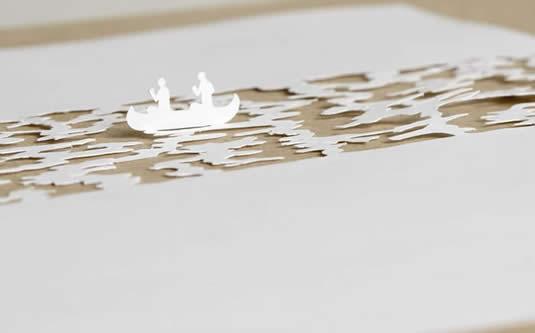
Down the River by the awe-inspiring Peter Callesen.
In a few posts, I’ve let slip that Paper Doll isn’t particularly artistic or craftsy. At all. But a girl can dream, and Creative Park, Cannon’s 3d Paper art site, has free downloads for the more adept of you to turn 2-dimensional paper into 3-dimensional art, including animals, dinosaurs, elements of a whole tiny town (from firehouse to amusement park), to little cars like these:

September is just ending, but for those of you already excited about Halloween, 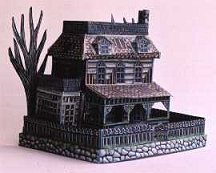 , the free paper toys and masks you can create from the toyshop at Raven’s Blight are eerily cool. Yes, it’s creepy and scary, but beauty is in the eye of the beholder and I am amazed at the artistry involved.
, the free paper toys and masks you can create from the toyshop at Raven’s Blight are eerily cool. Yes, it’s creepy and scary, but beauty is in the eye of the beholder and I am amazed at the artistry involved.
And given some recent stock market activity (ahem), perhaps it’s a good idea if we can appreciate Cool Stuff We Can Do With Paper Money (besides spend it), like:
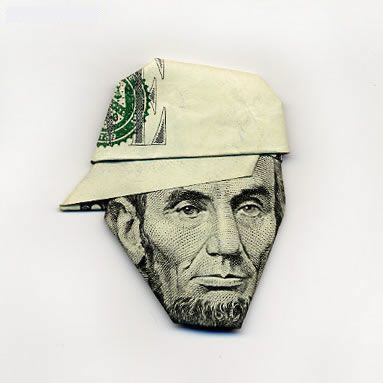 and
and 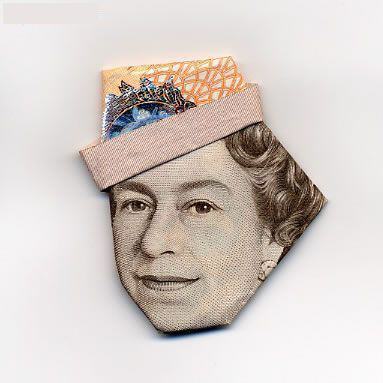
And if you’re looking for paper (money) that looks a little more 3-dimensional, check out the work of Mark Skye, the Dollar Artist, whose sculptured creations range from amazingly functional  to charmingly fanciful
to charmingly fanciful  to adorably fashionable
to adorably fashionable 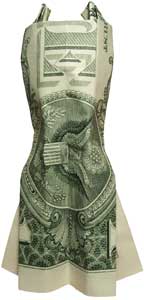 .
.
It’s been a remarkable year, and I want to thank all of Paper Doll‘s readers for the support and encouragement. Hopefully, you’ve noticed some new features around the site, like the RSS feeds and the long-awaited open comments, so you can share your thoughts without registration (or reservation).
Next week, Paper Doll will begin a second year: sharing thoughts, commentary, resources and goofiness on all things related to organizing our paper and our lives. Until then, Happy New Year!
Wanted: An Organized Mind (To Create An Organized Wish List)
Inspired, as always, by the topic of paper organizing but unable to determine the focus of this week’s post, Paper Doll took a break to work out. I’ve been cross-training in preparation for this Sunday’s Chattanooga Komen Race for the Cure, and among my Netflix arrivals was Tamilee Webb’s I Want That Body, with segments like I Want Those Abs, I Want Those Arms, etc. Paper Doll isn’t the most coordinated or focused workout gal, and eventually got distracted.
A loose thread of thought reminded me of “I want…I want…I want!”, a phrase repeated by Eugene Henderson, the protagonist of Saul Bellow’s novel Henderson, The Rain King. I’ll admit I never cared for the book, which seems like Fitzgerald crossed with indigestion. I mostly found it memorable because Ally McBeal once quoted the “I want…I want…I want!” with ferocity.
Ally reminded me of a handful of DVDs I want…and I think you’re getting the picture. A long way to go to get to the topic of keeping track of what we want.
I’ve worked with clients whose paper clutter included large piles of clippings and marked pages, representing what they wanted:
- Layers of thick home dcor magazines illustrating remodeling options…representing anything from a desire for an updated home to a deep-seated annoyance with a spouse, job or life which only a whole new home could deliver
- Printouts from Jeri Dansky’s great blog, Organizing & Decluttering News depicting aesthetically-pleasing and yet entirely practical organizing tools…which, to someone suffering from disorganization, can mean faith, hope and the possibility of being both clutter-free and FABulous!
- Hand-scribbled notes regarding movie recommendations…to view if time and space weren’t so generally out of control
- Catalogs and catalog page clippings with circles and arrows and a paragraph on the back of each one saying which was a prospective holiday gift for whom
Pages and piles representing what people need/want, and in some cases, taking up space that could otherwise be given over to the very thing that’s desired…this is the clutter of want.
Don’t worry–this isn’t a diatribe on consumerism in dire economic times. This is just a way to deal with all the little reminders of goodies you might, someday, if you remember to know that such things exists, kinda, sorta, want to acquire:
1) Don’t keep whole magazines when one or a few items appeal to you.
We’ve talked before about what happens when we become clutter-rich but information poor. When you read a magazine, the point is to learn, absorb, and become entertained; keeping all of your magazines “just in case” you want to find something you saw in an ad or article clutters your life without delivering the goods.
A magazine’s web site will almost assuredly have a searchable database of articles and editorial content, but nowhere on the web or in any magazine will you be able to search and find in which year, issue, and page you saw a golf gadget, wrinkle-reducer or baby outfit.
At the very least (i.e., if the tech-savvy advice down below doesn’t resonate with you), follow my prior advice and/or carefully tear or cut out the few pages reflecting the items you might like to purchase, file the items in a project notebook or interest file, and once you’ve read the rest of the magazine, recycle.
2) Don’t keep whole catalogs.
For those to whom catalogs provide a chance to dream, the suggestion of unsubscribing will seem impossible. Fair enough. So, flip through the pages. Note that the toll-free number and the URL of the company is on at least every other page. Catalogs are designed this way to ensure that if the page depicting the desired item is separated from the catalog as a whole, the consumer can still easily and quickly make a purchase, either by phone or web.
So, instead of holding on to whole catalogs (especially catalogs that are more than one season or year old, depending on frequency of distribution), just keep the page of the nifty item you might like to buy.
3) Don’t save snippets of pages.
Let’s say you’re an Oprah devote and love The O List in the monthly magazine. Each such page has a vast array of nifty products that will transform your life.
If you clip out just the corner of the page depicting the photo, description and ordering info, you’ve got an oddly-angled, 1/5th of a piece of paper…if you’re a regular Paper Doll reader, you know that’s a floozy! Saving a partial piece of paper makes it more likely it will get lost, tossed or otherwise forgotten. So if you see something you must have, clip the whole page and circle the object if there’s any chance that three months later, you won’t recall whether you wanted the ultra-modern steak knives or the solar-powered hair dryer.
4) Don’t print web pages depicting items you want to purchase.
Aside from the tree-killing aspect, it’s silly to print out a page when you’ve got the ability to let the digital representation live right on your computer, either via a bookmark (see #5, below) or screen capture. A web page has clickable, interactive links and the URL you can forward to say “Hey, see the earrings on this page? Hint, hint.” You can’t click on an embedded link on a piece of paper, and a print-out can’t reflect updates in price, inventory status, or other variables.
5) Don’t save ANY pages when you can go digital instead.
Sift through newspapers or magazines as usual Clip all the pictures, ads and other fabulous prospective purchases Collect all the loose pieces of paper in a manila folder to keep with your action papers or a tickler file. Determine how often you want (and can afford) to shop and schedule a shopping block on your calendar or in your PDA. At the appointed day/time, sit down at your computer with the “Stuff To Buy” folder.
No matter what web browser you’re using, you have the ability to bookmark the product description of the item. This is the simplest way to capture the ordering page for whatever you want so that you can access it whenever, wherever you feel the need to make an acquisition. You always know where your computer is; if you have sixteen piles of papers meandering from the microwave to the kitchen counter to the coffee table to the top of your dresser, what’s the chance that you’ll find exactly the clipped page you want when you want it? (Social bookmarking through sites like Digg and StumbleUpon can also help you keep track of prospective purchases.)
A long tower of unsorted digital bookmarks is only marginally less of an annoyance than a tall tower of paper clutter in your home or office. It has the advantage of taking up a small spatial footprint, but it still requires you to carefully search, especially if your bookmarks aren’t organized or even alphabetized.
Instead, create a bookmark folder for “Pending Purchases”, then create sub-folders (and even sub-sub folders if you need more categories) just as you would subdivide a filing cabinet into hanging folders and manila folders. Sub-folders could be labeled as “Holiday Presents”, “Office Tools”, “Clothing”. The key is to divide and label the categories in such a way that you can easily find whatever you’re seeking when a need arises. For example, Paper Doll has a bookmark folder labeled “Fun For Me”, including bunny slippers, a Jane Austen action figure, and this…and I have to admit none of it is for blog research.
Bookmarks are great if you merely want to replace the clutter of clipped pages with a streamlined way to shop. But outside of emailing a link to someone who asks “What would you like for [insert occasion here]
In the past, creating a wish list was like registering for a wedding or baby shower. You went to a store site and marked what you wanted that was carried by that specific store. Like a registry, that still meant you had to tell people where you were registered, and listing too many places seemed greedy. Enter: Universal Wish Lists!
Amazon.com, now lets you register for anything you see at ANY store, anywhere online, on your Amazon wish list. Start a list and add the widget to your browser’s bookmark toolbar to add items to the wish list. Whether you’ve just found something while surfing or are perusing clipped items on your scheduled shopping day, one click saves anything on the web to your wish list.
Froogle’s Shopping List has a universal wish list, too. Just sign into your Google account, and start adding items from all over the web. You can share with others to use it as a wish list, or keep it private so it provides web-accessible bookmarks from any computer. Froogle’s Shopping List lets you annotate product pages with your own comments and sort by price, item or date.
I would be remiss if I didn’t note that there are charity wish lists, too, so instead of being surrounded by piles all the direct mail and clipped print ads for non-profits to whom you’d like to give (or would like donations made on your behalf), you can select the causes closest to your heart.
Until then, when something shiny makes you think, like Henderson, the Rain King, “I want…I want…I want!”, cut the clutter of excess magazines, catalogs and paper, streamline your desires digitally, and you’ll not only be more likely to get what you want, but to find it once it’s yours!




Follow Me